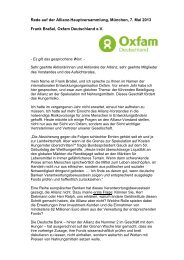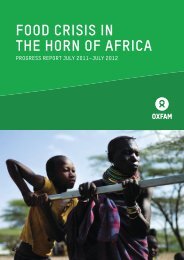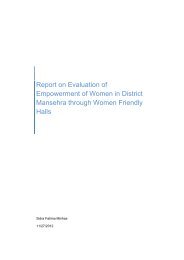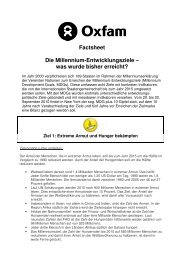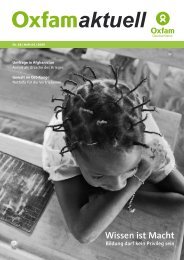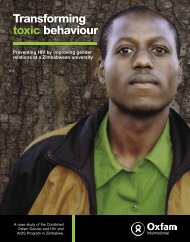No Time to Lose - Oxfam
No Time to Lose - Oxfam
No Time to Lose - Oxfam
You also want an ePaper? Increase the reach of your titles
YUMPU automatically turns print PDFs into web optimized ePapers that Google loves.
Contribu<strong>to</strong>rs <strong>to</strong> the ANA Trust<br />
Fund 15 September 2010<br />
Germany<br />
Australia<br />
Netherlands<br />
<strong>No</strong>rway<br />
Luxembourg<br />
Japan<br />
UK<br />
Denmark<br />
Spain<br />
Italy<br />
Turkey<br />
Finland<br />
Sweden<br />
Czech Republic<br />
Slovenia<br />
Bulgaria<br />
Switzerland<br />
Es<strong>to</strong>nia<br />
Lithuania<br />
$68.7m<br />
$44.5m<br />
$31.1m<br />
$22.6m<br />
$13.4m<br />
$11.7m<br />
$6.2m<br />
$5.8m<br />
$5.5m<br />
$4.3m<br />
$2.1m<br />
$1.5m<br />
$1.2m<br />
$0.4m<br />
$0.3m<br />
$0.2m<br />
$0.2m<br />
$0.1m<br />
$0.1m<br />
Source: ‘Equipping and Sustaining<br />
the Afghan National Army: NATO-<br />
ANA Trust Fund’ (NATO Fact Sheet,<br />
Oc<strong>to</strong>ber 2010)<br />
The US has been by far the largest contribu<strong>to</strong>r <strong>to</strong> Afghanistan’s security<br />
sec<strong>to</strong>r, having provided nearly $30bn <strong>to</strong> the Afghan Security<br />
Forces Fund. 21 Contributions <strong>to</strong> the ANA Trust Fund amounted <strong>to</strong><br />
nearly $377m as of September 2010, with substantial contributions<br />
from Germany, Australia, the Netherlands and <strong>No</strong>rway. 22 Total contributions<br />
<strong>to</strong> the Law and Order Trust Fund amounted <strong>to</strong> $1.7bn as of<br />
September 2010, with substantial contributions from the US, the EU<br />
and Japan. 23 Many states (NATO and non-NATO) have also exported<br />
sizeable amounts of military equipment <strong>to</strong> Afghanistan. 24<br />
Training the Afghan National Army<br />
Training and men<strong>to</strong>ring for the ANA, well as the planning and execution<br />
of ANA operations, is overseen by NTM-A/CSTC-A. 25 Recruits<br />
receive eight weeks of basic training, and this is followed – for<br />
roughly one third of recruits – by five weeks of advanced combat<br />
training. Following initial training, the international community’s<br />
primary mechanism for men<strong>to</strong>ring the ANA is through ‘Embedded<br />
Training Teams’ (US-led) and ‘Operational Men<strong>to</strong>r and Liaison<br />
Teams’ (led by non-US NATO partners), which live and work with<br />
ANA units. 26<br />
Despite substantial investment and some progress, the ANA continues<br />
<strong>to</strong> suffer from shortfalls in training personnel, faulty equipment,<br />
poor infrastructure and logistics, and high attrition rates. The development<br />
of the ANA has been characterised by a focus on quantity<br />
over quality, and a focus on infantry training at the expense of attention<br />
<strong>to</strong> non-combat training and the development of logistics capabilities.<br />
27 A US Department of Defense report <strong>to</strong> Congress in <strong>No</strong>vember<br />
2010 acknowledged that ‘logistics planning remains more of a discussion<br />
<strong>to</strong>pic than a <strong>to</strong>ol for execution,’ that partnered units were heavily<br />
reliant on ISAF <strong>to</strong> control operations, and that staff members’ low literacy<br />
levels hindered their ability <strong>to</strong> effectively manage staff functions<br />
and exercise command and control. 28<br />
Training the Afghan National Police<br />
Police reform in Afghanistan was initially led by Germany, following<br />
the division of responsibilities for security sec<strong>to</strong>r reform in 2002. But<br />
the German effort was fraught with problems, and in 2003 the US<br />
stepped up its own support for the ANP under the State Department’s<br />
Bureau of International Narcotics and Law Enforcement Affairs (INL).<br />
By 2004 US assistance exceeded the German program, and in 2005 – in<br />
a move that sits awkwardly with current US policy regarding State<br />
Department leadership of security sec<strong>to</strong>r reform 29 – the US Department<br />
of Defense <strong>to</strong>ok over from the INL as the lead ac<strong>to</strong>r (through<br />
NTM-A/CSTC-A) for US police training and institutional development.<br />
Since 2007 EUPOL (which has now formally taken over from<br />
10




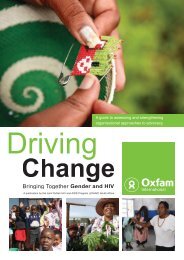

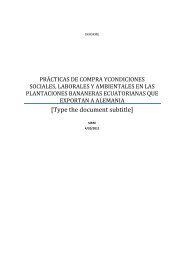
![Download: Faltposter EU-Handelspolitik [PDF 2,17MB] - Germanwatch](https://img.yumpu.com/25095854/1/190x161/download-faltposter-eu-handelspolitik-pdf-217mb-germanwatch.jpg?quality=85)
